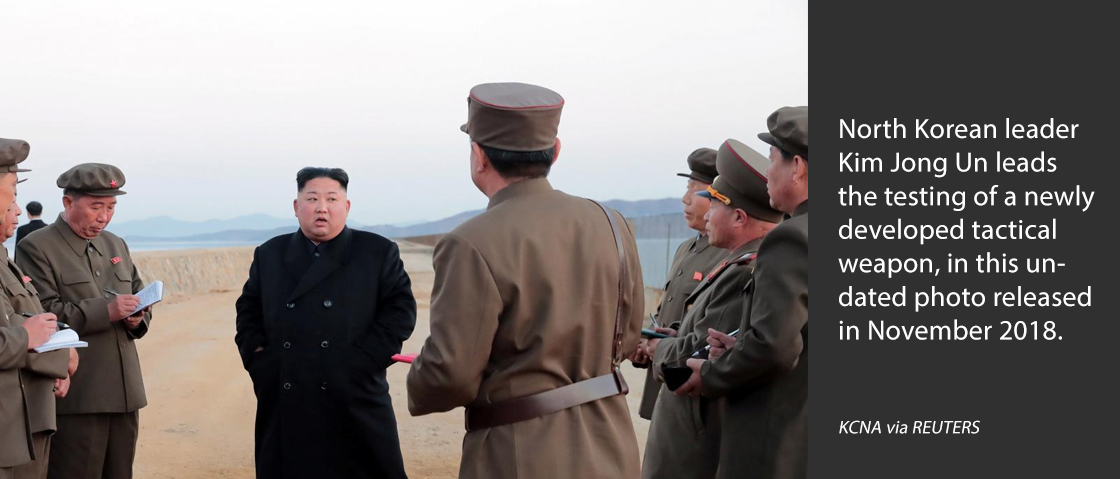Is a much larger escalation on the horizon?
After 522 days without a ballistic missile test, North Korea is at it again. On May 4, two months after the failed Hanoi summit, Pyongyang fired a new type of solid-fuel short range ballistic missile and tested two separate multiple rocket launch systems. Any hope that the test was a one-off evaporated just five days later, when North Korea again launched several of the new short range ballistic missiles, one of which traveled as far as 420 kilometers.
Both South Korea and the United States went to great lengths to downplay the tests’ significance. To be sure, Kim hasn’t broken any promises he has made to the United States since 2018. North Korea’s self-imposed moratorium on missile testing, declared explicitly in April of that year, applied only to intercontinental range ballistic missiles (ICBMs). In an interview following the May 4 test, U.S. Secretary of State Mike Pompeo stated that the United States believes that North Korea remains in compliance, noting that the moratorium “was focused, very focused, on intercontinental missile systems, the ones that threaten the United States for sure.” Pompeo did not mention standing UN Security Council Resolutions that prohibit any ballistic missile tests by North Korea.
Unfortunately, Pompeo’s comments may have inadvertently signaled to Kim that the United States will tolerate—and continue to look the other way on—tests short of ICBM range. But such shorter-range missiles still threaten South Korea, Japan, and American forces deployed in Northeast Asia. For the United States to suggest disinterest in North Korea’s tests could leave Americans less safe and undercut the concerns of allied countries.
In the wake of the Hanoi summit’s failure—after which North Korean officials suggested that Kim may have “lost the will to negotiate further”—Pyongyang’s renewed commitment to testing missiles certainly looks ominous, and could portend a turn back to a confrontation between the United States and North Korea. What precipitated Kim’s first ballistic missile test in almost a year and a half?
TIMING IS EVERYTHING
Not coincidentally, North Korea conducted its most recent missile tests just after the United States and South Korea commenced a new joint military exercise, known as Dong Maeng. The exercise, in its inaugural iteration this year, replaces the larger-scale Foal Eagle and Key Resolve springtime exercises that the allies carried out previously. Even as it represented reduced scope allied activities amid diplomacy, Kim described it as a violation of a direct commitment U.S. President Donald Trump had given him, saying the drills “seriously rattle” Pyongyang.
Kim sees Dong Maeng as a manifestation of Washington’s “hostile policy” and a violation of the joint declaration he and Trump issued in Singapore in 2018. In an April 13 speech to the Supreme People’s Assembly, Kim warned that the combined exercise, along with Washington’s test, in March, of an anti-ICBM defense system, would have consequences. The “wind is bound to bring waves,” Kim warned: Pyongyang would respond with “corresponding acts” for these transgressions. And sure enough, Kim answered exercise with exercise, while making sure to largely calibrate the intensity of his missile tests to match that of the allied drills. The cycle of provocations is likely to continue between the two sides. Just last week, North Korea lashed out at the U.S. Justice Department’s seizure of the sanctions-busting Wise Honest ship, describing the move as a further violation of the Singapore declaration.

North Korean military conducts a "strike drill" for multiple launchers, May 2019
For Kim, the relationship with Trump carries high stakes domestically as well as internationally. North Korean officials have made statements implying that the leader put a lot on the line at home to negotiate directly with the U.S. president in Singapore and—especially—Hanoi. At a press conference in Pyongyang in March, one of Kim’s most senior diplomats said that he had faced “thousands of petitions” from various constituents, including “officials [of] the munitions industry,” warning him not to not let talks with the United States lead to abandoning the country’s nuclear weapons. These petitions aren’t literal given Kim’s monolithic decision-making ability, but the comment was a reminder that negotiations with the United States aren’t likely to have received universal support across the party bureaucracy. When Kim walked away from Hanoi empty-handed, these skeptics may have felt vindicated. For example, in April, at a lower-key “guided weapon test,” some of North Korea’s best-known so-called missile men—Jang Chang Ha and Jon Il Ho, for instance—made their first public appearances since 2017, presaging the new round of test activity.
Testing short-range conventional missiles not only boosts the morale of Kim’s forces but satisfies bureaucratic hard-liners that Kim will indeed pursue a “new way” if the United States fails to relieve sanctions. By showcasing North Korea’s improvement of, and increasing comfort with, advanced solid-fuel missiles—which Pyongyang had presumably been working on during the moratorium and which provide significant advantages in terms of responsiveness, survivability, and their ability to potentially defeat missile defenses—Kim is reassuring his military that he remains committed to a strong national defense even as he negotiates with Washington. North Korea needs a “self-reliant national defense,” Kim told the country in April: “Peace can be ensured only by powerful military capabilities.” Pyongyang’s “new way” may turn out to be simply more of the old way.
Kim likely aims not only to appeal to hard-liners at home but to pressure hard-liners in Washington as well. In Hanoi, Trump tried to “go big or go home,” demanding that North Korea unilaterally surrender its entire nuclear and ballistic missile program before it could get any major sanctions relief. This maximalist position was, unsurprisingly, a nonstarter for Kim. He walked away when the United States refused to entertain a step-by-step approach that might have begun with, for example, the dismantlement of key facilities at the Yongbyon nuclear complex.
Since then, working-level negotiations have seemingly remained in a coma, and North Korea has strongly criticized Pompeo and National Security Adviser John Bolton for allegedly convincing Trump to stick to the maximalist position. Pyongyang has even demanded that Pompeo be removed from the negotiations. The missile tests serve to remind Trump that North Korea can turn up the temperature quickly if a deal fails to materialize—and that this time, unlike in 2017, there will be no diplomatic off-ramp. In effect, Pyongyang has taken a “maximum pressure” approach of its own.
DIPLOMACY’S EXPIRATION DATE
Ominously, North Korea has signaled that the new tests may be a prelude to a much larger escalation. Trump insists he is in “no rush” on denuclearization or to move talks forward, but Pyongyang has set a very clear deadline—the end of this calendar year—for getting negotiations back on track and for the United States to moderate its position. Otherwise, Vice Foreign Minister Choe Son-hui has admonished, the United States will face unspecified “undesired consequences.” Pompeo has dismissed this deadline as nothing “particularly significant.” But North Korea has a strong track record of following through on its threats, and history may rhyme, if not repeat itself, this year.
In March 2005, the country’s foreign ministry announced that Pyongyang no longer considered itself bound by a moratorium it had negotiated six years earlier. In March 2006, it proceeded to test short-range Toksa missiles similar to the missiles it has tested recently, and then on July 4, 2006, it followed up with multiple longer-range ballistic missiles and a single satellite launch vehicle, which shares characteristics with long-range missiles. This time, unlike in 2005, Washington may not receive formal warning that Kim no longer feels bound by the moratorium, since it is self-imposed. At the very least, Kim’s restraint on missile testing is slackening and the administration ignores the end-of-year deadline at its peril.
North Korea’s missile tests risk leading the Trump administration not to moderate its position but to double down on its hard line.
Certainly, this North Korean variant on “maximum pressure” is risky for Pyongyang. If Trump decides that Kim has betrayed him by testing one missile too many or too far, he could reverse course and, instead of standing “with [Kim],” lash out at North Korea. Since Hanoi, Bolton has become the administration’s messenger of choice, and he has long advocated an alternative to denuclearization by diplomacy: denuclearizing North Korea by force. Bolton emphasizes that the only deal worth making with Pyongyang would be a grand bargain that trades total disarmament up front for total sanctions relief, and only after North Korea has completely surrendered. North Korea’s missile tests risk leading the administration not to moderate its position but to double down on its hard line, lest it appear as if it is succumbing to North Korean pressure. Even if the administration does not respond militarily, the U.S. Treasury Department could unleash new sanctions, leading North Korea to escalate in turn. The resulting spiral could preclude any possible return to the Singapore process.
THE RIGHT U.S. OBJECTIVES
Kim’s message to the United States, particularly since Hanoi, has been that any further progress toward denuclearization and improved relations will require Washington to make the next move, primarily through sanctions relief. As Kim sees the matter, he refrained from conducting weapons tests last year, and so he is owed, and has earned, that relief. Now he is content to return to his old ways slowly if no “corresponding measures” materialize, particularly as he has repaired his relationship with China and resurrected a historical relationship with Russia. Trump, however, says he sees North Korea’s latest test as evidence that Pyongyang isn’t “ready to negotiate.”
Momentum for a return to the working-level dialogue appears to be quickly vanishing. If the administration hopes to resurrect that dialogue with North Korea on its nuclear weapons program, it would do well to take Kim’s end-of-year deadline seriously. To do so will require reexamining U.S. objectives. A good deal—one that reduces risks and at least begins to slow the growth of the North Korean nuclear and missile programs—is preferable to a quixotic quest for the “final, fully verified denuclearization of North Korea.” Each day that passes without a grand deal is one where North Korea’s nuclear and missile programs continue to expand and improve, further reducing Washington’s leverage. If North Korea’s end-of-year deadline passes without a shift in the U.S. negotiating position, Kim may ring in the New Year with a bang.




